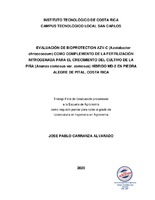Evaluación de bioprotection azv-c (Azotobacter choococcum) como complemento de la fertilización nitrogenada para el crecimiento del cultivo de la piña (Ananas comosus var. comosus) híbrido md-2 en Piedra Alegre de Pital, Costa Rica
Resumen
El objetivo de esta investigación fue evaluar el efecto de Bioprotection AZV-C (Azotobacter chroococcum) como complemento de fertilización nitrogenada preforzamiento, por su función como organismo diazótrofo. El estudio tuvo lugar en la finca Agroindustrial Tres Amigos S.A., ubicada en Pital de San Carlos; el mismo dio inicio en junio del 2019 con la siembra y finalizó en marzo del 2020 con la inducción floral. Los tratamientos se plantearon haciendo una reducción del 20% (T2), 30% (T3), 40% (T4) y 50% (T5) respecto a la dosis comercial utilizada por la finca (T1). Las reducciones se mantuvieron los primeros seis ciclos de fertilización y Bioprotection AZV-C fue agregado en cuatro de ellos. A partir del séptimo ciclo de fertilización se continuó con el 100% de nitrógeno en todos los tratamientos. Las variables evaluadas fueron peso fresco planta, peso seco planta, contenido foliar de nitrógeno, peso, longitud, ancho y área foliar de la hoja D, número de hojas en la planta y finalmente la población de A. chroococcum en el área experimental. Se determinó que los tratamientos 100% nitrógeno (finca), reducción 20% + Bioprotection y reducción 30% + Bioprotection, ofrecieron las mayores tasas de crecimiento, sin presentar diferencias significativas (p>0,05) entre sí en la mayoría de las variables estudiadas. Asimismo, las reducciones 20% + Bioprotection y 30% + Bioprotection generaron una reducción de costos respecto a lo utilizado por la finca (T1). The objective of this research was to evaluate the effect of Azotobacter chroococcum as a pre-forcing nitrogen fertilization complement, due to its function as a diazotrophic organism. The study took place at the Agroindustrial Tres Amigos S.A. farm, located in Pital de San Carlos. It began in June 2019 with the sowing and ended in March 2020 with the floral induction. The treatments were stablished making a reduction of 20% (T2), 30% (T3), 40% (T4) and 50% (T5) with respect to the commercial amount used by the farm (T1). The reductions were maintained for the first six fertilization cycles and Bioprotection AZV-C was added in four of them. From the seventh fertilization cycle onwards, 100% nitrogen was added in all treatments. The variables evaluated were plant fresh weight, plant dry weight, leaf nitrogen content, weight, length, width and leaf area of D leaf, number of leaves on the plant and finally the population of A. chroococcum in the experimental area. It was determined that treatments 100% nitrogen (farm), 20% reduction + Bioprotection and 30% reduction + Bioprotection, provided the highest growth rates, without displaying significant differences (p>0.05) between them in most of the variables studied. Likewise, the reductions of 20% + Bioprotection and 30% + Bioprotection, generated a cost reduction with respect to what is used by the farm (T1).
Descripción
Proyecto de Graduación (Licenciatura en Ingeniería en Agronomía) Instituto Tecnológico de Costa Rica, Escuela de Ingeniería en Agronomía, 2020


